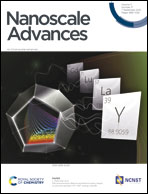Rectifying optoelectronic memory based on WSe2/graphene heterostructures†
Abstract
van der Waals heterostructures composed of two-dimensional materials vertically stacked have been extensively studied to develop various multifunctional devices. Here, we report WSe2/graphene heterostructure devices with a top floating gate that can serve as multifunctional devices. They exhibit gate-controlled rectification inversion, rectified nonvolatile memory effects, and multilevel optoelectronic memory effects. Depending on the polarity of the gate voltage pulses (VGp), electrons or holes can be trapped in the floating gate, resulting in rectified nonvolatile memory properties. Furthermore, upon repeated illumination with laser pulses, positive or negative staircase photoconductivity is observed depending on the history of VGp, which is ascribed to the tunneling of electrons or holes between the WSe2 channel and the floating gate. These multifunctional devices can be used to emulate excitatory and inhibitory synapses that have different neurotransmitters. Various synaptic functions, such as potentiation/depression curves and spike-timing-dependent plasticity, have been also implemented using these devices. In particular, 128 optoelectronic memory states with nonlinearity less than 1 can be achieved by controlling applied laser pulses and VGp, suggesting that the WSe2/graphene heterostructure devices with a top floating gate can be applied to optoelectronic synapse devices.



 Please wait while we load your content...
Please wait while we load your content...